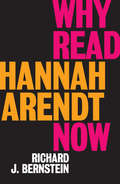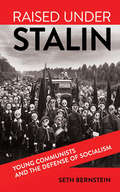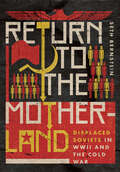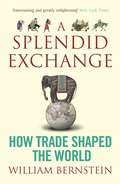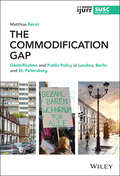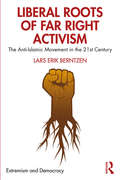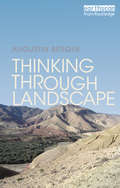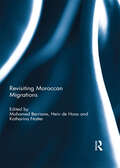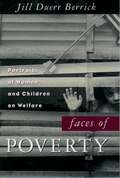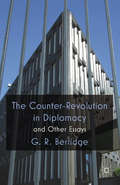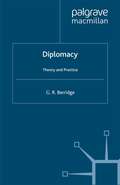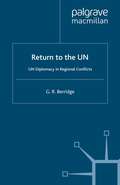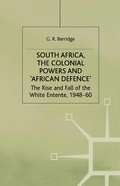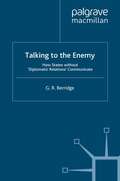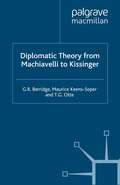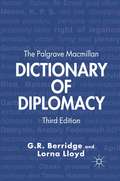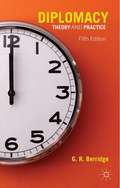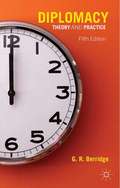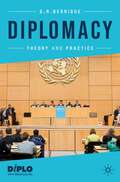- Table View
- List View
Violence: Thinking without Banisters
by Richard J. BernsteinWe live in a time when we are overwhelmed with talk and images of violence. Whether on television, the internet, films or the video screen, we can’t escape representations of actual or fictional violence - another murder, another killing spree in a high school or movie theatre, another action movie filled with images of violence. Our age could well be called “The Age of Violence” because representations of real or imagined violence, sometimes fused together, are pervasive. But what do we mean by violence? What can violence achieve? Are there limits to violence and, if so, what are they? In this new book Richard Bernstein seeks to answer these questions by examining the work of five figures who have thought deeply about violence - Carl Schmitt, Walter Benjamin, Hannah Arendt, Frantz Fanon, and Jan Assmann. He shows that we have much to learn from their work about the meaning of violence in our times. Through the critical examination of their writings he also brings out the limits of violence. There are compelling reasons to commit ourselves to non-violence, and yet at the same time we have to acknowledge that there are exceptional circumstances in which violence can be justified. Bernstein argues that there can be no general criteria for determining when violence is justified. The only plausible way of dealing with this issue is to cultivate publics in which there is free and open discussion and in which individuals are committed to listen to one other: when public debate withers, there is nothing to prevent the triumph of murderous violence.
Why Read Hannah Arendt Now?
by Richard J. BernsteinRecently there has been an extraordinary international revival of interest in Hannah Arendt. She was extremely perceptive about the dark tendencies in contemporary life that continue to plague us. She developed a concept of politics and public freedom that serves as a critical standard for judging what is wrong with politics today. Richard J. Bernstein argues that Arendt should be read today because her penetrating insights help us to think about both the darkness of our times and the sources of illumination. He explores her thinking about statelessness and refugees; the right to have rights; her critique of Zionism; the meaning of the banality of evil; the complex relations between truth, lying, power, and violence; the tradition of the revolutionary spirit; and the urgent need for each of us to assume responsibility for our political lives. This short and very readable book will be of great interest to anyone who wants to understand the forces that are shaping our world today.
Raised under Stalin: Young Communists and the Defense of Socialism
by Seth BernsteinIn Raised under Stalin, Seth Bernstein shows how Stalin’s regime provided young people with opportunities as members of the Young Communist League or Komsomol even as it surrounded them with violence, shaping socialist youth culture and socialism more broadly through the threat and experience of war. Informed by declassified materials from post-Soviet archives, as well as films, memoirs, and diaries by and about youth, Raised under Stalin explains the divided status of youth for the Bolsheviks: they were the "new people" who would someday build communism, the potential soldiers who would defend the USSR, and the hooligans who might undermine it from within. Bernstein explains how, although Soviet revolutionary youth culture began as the preserve of proletarian activists, the Komsomol transformed under Stalin to become a mass organization of moral education; youth became the targets of state repression even as Stalin’s regime offered them the opportunity to participate in political culture. Raised under Stalin follows Stalinist youth into their ultimate test, World War II. Even as the war against Germany decimated the ranks of Young Communists, Bernstein finds evidence that it cemented Stalinist youth culture as a core part of socialism.
Return to the Motherland: Displaced Soviets in WWII and the Cold War (Battlegrounds: Cornell Studies in Military History)
by Seth BernsteinReturn to the Motherland follows those who were displaced to the Third Reich back to the Soviet Union after the victory over Germany. At the end of World War II, millions of people from Soviet lands were living as refugees outside the borders of the USSR. Most had been forced laborers and prisoners of war, deported to the Third Reich to work as racial inferiors in a crushing environment. Seth Bernstein reveals the secret history of repatriation, the details of the journey, and the new identities, prospects, and dangers for migrants that were created by the tumult of war. He uses official and personal sources from declassified holdings in post-Soviet archives, more than one hundred oral history interviews, and transnational archival material. Most notably, he makes extensive use of secret police files declassified only after the Maidan Revolution in Ukraine in 2014. The stories described in Return to the Motherland reveal not only how the USSR grappled with the aftermath of war but also the universality of Stalinism's refugee crisis. While arrest was not guaranteed, persecution was ubiquitous. Within Soviet society, returnees met with a cold reception that demanded hard labor as payment for perceived disloyalty, soldiers perpetrated rape against returning Soviet women, and ordinary people avoided contact with repatriates, fearing arrest as traitors and spies. As Bernstein describes, Soviet displacement presented a challenge to social order and the opportunity to rebuild the country as a great power after a devastating war.
A Splendid Exchange: How Trade Shaped the World (Playaway Adult Nonfiction Ser.)
by William L BernsteinA Splendid Exchange tells the epic story of global commerce, from its prehistoric origins to the myriad crises confronting it today. It travels from the sugar rush that brought the British to Jamaica in the seventeenth century to our current debates over globalization, from the silk route between China and Rome in the second century to the rise and fall of the Portuguese monopoly in spices in the sixteenth. Throughout, William Bernstein examines how our age-old dependency on trade has contributed to our planet's agricultural bounty, stimulated intellectual and industrial progress and made us both prosperous and vulnerable.
The Commodification Gap: Gentrification and Public Policy in London, Berlin and St. Petersburg (IJURR Studies in Urban and Social Change Book Series)
by Matthias BerntTHE COMMODIFICATION GAP ‘In an elegant and careful theoretical analysis, this book demonstrates how gentrification is always entwined with institutions and distinctive contextual processes. Matthias Bernt develops a new concept, the “commodification gap”, which is tested in three richly researched cases. With this, the concept of gentrification becomes a multiplicity and the possibility of conversations across different urban contexts is expanded. A richly rewarding read!’ —Jennifer Robinson, Professor of Human Geography, University College London, UK ‘Urban studies has reached a stalemate of universalism versus particularism. Matthias Bernt is breaking out of this deadlock by being very precise about what exactly is universal and what is not – and how one can conceptualize both. The Commodity Gap is a key contribution to not only gentrification studies, but also to comparative urbanism and urban studies at large.’ —Manuel B. Aalbers, Division of Geography & Tourism, KU Leuven, Belgium The Commodification Gap provides an insightful institutionalist perspective on the field of gentrification studies. The book explores the relationship between the operation of gentrification and the institutions underpinning - but also influencing and restricting - it in three neighborhoods in London, Berlin and St. Petersburg. Matthias Bernt demonstrates how different institutional arrangements have resulted in the facilitation, deceleration or alteration of gentrification across time and place. The book is based on empirical studies conducted in Great Britain, Germany and Russia and contains one of the first-ever English language discussions of gentrification in Germany and Russia. It begins with an examination of the limits of the widely established “rent-gap” theory and proposes the novel concept of the “commodification gap.” It then moves on to explore how different institutional contexts in the UK, Germany and Russia have framed the conditions for these gaps to enable gentrification. The Commodification Gap is an indispensable resource for researchers and academics studying human geography, housing studies, urban sociology and spatial planning.
The Commodification Gap: Gentrification and Public Policy in London, Berlin and St. Petersburg (IJURR Studies in Urban and Social Change Book Series)
by Matthias BerntTHE COMMODIFICATION GAP ‘In an elegant and careful theoretical analysis, this book demonstrates how gentrification is always entwined with institutions and distinctive contextual processes. Matthias Bernt develops a new concept, the “commodification gap”, which is tested in three richly researched cases. With this, the concept of gentrification becomes a multiplicity and the possibility of conversations across different urban contexts is expanded. A richly rewarding read!’ —Jennifer Robinson, Professor of Human Geography, University College London, UK ‘Urban studies has reached a stalemate of universalism versus particularism. Matthias Bernt is breaking out of this deadlock by being very precise about what exactly is universal and what is not – and how one can conceptualize both. The Commodity Gap is a key contribution to not only gentrification studies, but also to comparative urbanism and urban studies at large.’ —Manuel B. Aalbers, Division of Geography & Tourism, KU Leuven, Belgium The Commodification Gap provides an insightful institutionalist perspective on the field of gentrification studies. The book explores the relationship between the operation of gentrification and the institutions underpinning - but also influencing and restricting - it in three neighborhoods in London, Berlin and St. Petersburg. Matthias Bernt demonstrates how different institutional arrangements have resulted in the facilitation, deceleration or alteration of gentrification across time and place. The book is based on empirical studies conducted in Great Britain, Germany and Russia and contains one of the first-ever English language discussions of gentrification in Germany and Russia. It begins with an examination of the limits of the widely established “rent-gap” theory and proposes the novel concept of the “commodification gap.” It then moves on to explore how different institutional contexts in the UK, Germany and Russia have framed the conditions for these gaps to enable gentrification. The Commodification Gap is an indispensable resource for researchers and academics studying human geography, housing studies, urban sociology and spatial planning.
Liberal Roots of Far Right Activism: The Anti-Islamic Movement in the 21st Century (Extremism and Democracy)
by Lars Erik BerntzenThis book explores the anti-Islamic turn and expansion of the far right in Western Europe, North America and beyond from 2001 and onwards. Driven by terror attacks and other moral shocks, the anti-Islamic cause has undergone four waves of transnational expansion in the period since 2001. The leaders and intellectuals involved have varied backgrounds, many coming from the left, uniting historically opposed sets of values under their banner of a civilizational struggle against Islam. The findings presented in this book indicate that anti-Islamic initiatives in Western Europe and the United States form a transnational movement and subculture characterized by a fragile balance between liberal and authoritarian values. The author draws on a broad array of data sources and methods, including network analysis and sentiment analysis, to analyze the impact of the anti-Islamic expansion and turn at a macro level, and the theoretical implications for our understanding of the current far right flowing from this. Offering an overview of anti-Islamic activism, the book explores the background of their leaders and ideologues, provides an in-depth look at their ideology, online organizational networks, and the views expressed by their online members as well as which emotions and messages continue to drive their mobilization. The book will be of interest to scholars in the social movement field as well as political scientists, sociologists, and general readers interested in issues such as populism, extremism and understanding the ways in which the contemporary far right challenges liberal democracies.
Liberal Roots of Far Right Activism: The Anti-Islamic Movement in the 21st Century (Extremism and Democracy)
by Lars Erik BerntzenThis book explores the anti-Islamic turn and expansion of the far right in Western Europe, North America and beyond from 2001 and onwards. Driven by terror attacks and other moral shocks, the anti-Islamic cause has undergone four waves of transnational expansion in the period since 2001. The leaders and intellectuals involved have varied backgrounds, many coming from the left, uniting historically opposed sets of values under their banner of a civilizational struggle against Islam. The findings presented in this book indicate that anti-Islamic initiatives in Western Europe and the United States form a transnational movement and subculture characterized by a fragile balance between liberal and authoritarian values. The author draws on a broad array of data sources and methods, including network analysis and sentiment analysis, to analyze the impact of the anti-Islamic expansion and turn at a macro level, and the theoretical implications for our understanding of the current far right flowing from this. Offering an overview of anti-Islamic activism, the book explores the background of their leaders and ideologues, provides an in-depth look at their ideology, online organizational networks, and the views expressed by their online members as well as which emotions and messages continue to drive their mobilization. The book will be of interest to scholars in the social movement field as well as political scientists, sociologists, and general readers interested in issues such as populism, extremism and understanding the ways in which the contemporary far right challenges liberal democracies.
Thinking through Landscape
by Augustin BerqueOur attitude to nature has changed over time. This book explores the historical, literary and philosophical origins of the changes in our attitude to nature that allowed environmental catastrophes to happen.The book presents a philosophical reflection on human societies’ attitude to the environment, informed by the history of the concept of landscape and the role played by the concept of nature in the human imagination. It features a wealth of examples from around the world to help understand the contemporary environmental crisis in the context of both the built and natural environment. Berque locates the start of this change in human labour and urban elites being cut off from nature. Nature became an imaginary construct masking our real interaction with the natural world. He argues that this gave rise to a theoretical and literary appreciation of landscape at the expense of an effective practical engagement with nature. This mindset is a general feature of the world's civilizations, manifested in similar ways in different cultures across Europe, China, North Africa and Australia. Yet this approach did not have disastrous consequences until the advent of western industrialization.As a phenomenological hermeneutics of human societies’ environmental relation to nature, the book draws on Heideggerian ontology and Veblen’s sociology. It provides a powerful distinction between two attitudes to landscape: the tacit knowledge of earlier peoples engaged in creating the landscape through their work - “landscaping thought”- and the explicit theoretical and aesthetic attitudes of modern city dwellers who love nature while belonging to a civilization that destroys the landscape - “landscape thinking”. This book gives a critical survey of landscape thought and theory for students, researchers and anyone interested in human societies’ relation to nature in the fields of landscape studies, environmental philosophy, cultural geography and environmental history.
Thinking through Landscape
by Augustin BerqueOur attitude to nature has changed over time. This book explores the historical, literary and philosophical origins of the changes in our attitude to nature that allowed environmental catastrophes to happen.The book presents a philosophical reflection on human societies’ attitude to the environment, informed by the history of the concept of landscape and the role played by the concept of nature in the human imagination. It features a wealth of examples from around the world to help understand the contemporary environmental crisis in the context of both the built and natural environment. Berque locates the start of this change in human labour and urban elites being cut off from nature. Nature became an imaginary construct masking our real interaction with the natural world. He argues that this gave rise to a theoretical and literary appreciation of landscape at the expense of an effective practical engagement with nature. This mindset is a general feature of the world's civilizations, manifested in similar ways in different cultures across Europe, China, North Africa and Australia. Yet this approach did not have disastrous consequences until the advent of western industrialization.As a phenomenological hermeneutics of human societies’ environmental relation to nature, the book draws on Heideggerian ontology and Veblen’s sociology. It provides a powerful distinction between two attitudes to landscape: the tacit knowledge of earlier peoples engaged in creating the landscape through their work - “landscaping thought”- and the explicit theoretical and aesthetic attitudes of modern city dwellers who love nature while belonging to a civilization that destroys the landscape - “landscape thinking”. This book gives a critical survey of landscape thought and theory for students, researchers and anyone interested in human societies’ relation to nature in the fields of landscape studies, environmental philosophy, cultural geography and environmental history.
Noch mehr Sand im Getriebe?: Kommunikations- und Interaktionsprozesse zwischen Landes- und Regionalplanung, Politik und Unternehmen der Gesteinsindustrie (RaumFragen: Stadt – Region – Landschaft)
by Karsten Berr Corinna Jenal Lara Koegst Olaf KühneObwohl mineralische Rohstoffe wie beispielsweise Kies, Sand, Quarz und Naturstein auf vielfältige Weise Grundlagen menschlicher Existenz ermöglichen und garantieren, haben Vorhaben zur Gewinnung mineralischer Rohstoffe vielerorts mit unterschiedlichen Akzeptanzproblemen zu kämpfen. Der planerische Umgang mit Rohstoffsicherung und Rohstoffgewinnung wurde wissenschaftlich bislang hauptsächlich in Bezug auf ökologische oder fachplanerische Problemstellungen, weniger hingegen als teilsystemischer Aspekt in einem soziopolitischen Kontext betrachtet, der durch verstärkten Bürgerprotest und erneuerte Partizipations- und Demokratisierungsbestrebungen gekennzeichnet ist.
Revisiting Moroccan Migrations
by Mohammed Berriane Hein De Haas Katharina NatterOver the 20th century, Morocco has become one of the world’s major emigration countries. But since 2000, growing immigration and settlement of migrants from sub-Saharan Africa, the Middle East, and Europe confronts Morocco with an entirely new set of social, cultural, political and legal issues. This book explores how continued emigration and increasing immigration is transforming contemporary Moroccan society, with a particular emphasis on the way the Moroccan state is dealing with shifting migratory realities. The authors of this collective volume embark on a dialogue between theory and empirical research, showcasing how contemporary migration theories help understanding recent trends in Moroccan migration, and, vice-versa, how the specific Moroccan case enriches migration theory. This perspective helps to overcome the still predominant Western-centric research view that artificially divide the world into ‘receiving’ and ‘sending’ countries and largely disregards the dynamics of and experiences with migration in countries in the Global South. This book was previously published as a special issue of The Journal of North African Studies.
Faces Of Poverty: Portraits Of Women And Children On Welfare
by Jill Duerr BerrickMost Americans are insulated from the poor; it's hard to imagine the challenges of poverty, the daily fears of crime and victimization, the frustration of not being able to provide for a child. Instead, we are often exposed to the rhetoric and hyperbole about the excesses of the American welfare system. These messages color our perception of the welfare problem in the United States and they close the American mind to a full understanding of the complexity of family poverty. But who are these poor families? What do we know about how they arrived in such desperate straits? Is poverty their fate for a lifetime or for only a brief period? In Faces of Poverty , Jill Duerr Berrick answers these questions as she dispels the misconceptions and myths about welfare and the welfare population that have clouded the true picture of poverty in America. Over the course of a year, Berrick spent numerous hours as a participant-observer with five women and their families, documenting their daily activities, thoughts, and fears as they managed the strains of poverty. We meet Ana, Sandy, Rebecca, Darlene, and Cora, all of whom, at some point, have turned to welfare for support. Each represents a wider segment of the welfare population--ranging from Ana (who lost a business, injured her back, and temporarily lost her job, all in a short period of time) to Cora (who was raised in poverty, spent ten years in an abusive relationship, and now struggles to raise six children in a drug-infested neighborhood). And as Berrick documents these women's experiences, she also debunks many of the myths about welfare: she reveals that welfare is not generous (welfare families remain below the poverty line even with government assistance); that the majority of women on welfare are not long-term welfare dependents; that welfare does not run in families; that "welfare mothers" do not keep having children to increase their payments (women on welfare have, on average, two children); and that almost half of all women on welfare turned to it after a divorce. At a time when welfare has become a hotly debated political issue, Faces of Poverty gives us the facts. The debate surrounding welfare will continue as each of the 50 states struggles to reform their welfare programs, and this debate will turn on the public's perception of the welfare population. Berrick offers insight into each of the reforms under consideration and starkly demonstrates their implications for poor women and children. She provides a window into these women's lives, brilliantly portraying their hopes and fears and their struggle to live with dignity.
Faces of Poverty: Portraits of Women and Children on Welfare
by Jill Duerr BerrickMost Americans are insulated from the poor; it's hard to imagine the challenges of poverty, the daily fears of crime and victimization, the frustration of not being able to provide for a child. Instead, we are often exposed to the rhetoric and hyperbole about the excesses of the American welfare system. These messages color our perception of the welfare problem in the United States and they close the American mind to a full understanding of the complexity of family poverty. But who are these poor families? What do we know about how they arrived in such desperate straits? Is poverty their fate for a lifetime or for only a brief period? In Faces of Poverty, Jill Duerr Berrick answers these questions as she dispels the misconceptions and myths about welfare and the welfare population that have clouded the true picture of poverty in America. Over the course of a year, Berrick spent numerous hours as a participant-observer with five women and their families, documenting their daily activities, thoughts, and fears as they managed the strains of poverty. We meet Ana, Sandy, Rebecca, Darlene, and Cora, all of whom, at some point, have turned to welfare for support. Each represents a wider segment of the welfare population--ranging from Ana (who lost a business, injured her back, and temporarily lost her job, all in a short period of time) to Cora (who was raised in poverty, spent ten years in an abusive relationship, and now struggles to raise six children in a drug-infested neighborhood). And as Berrick documents these women's experiences, she also debunks many of the myths about welfare: she reveals that welfare is not generous (welfare families remain below the poverty line even with government assistance); that the majority of women on welfare are not long-term welfare dependents; that welfare does not run in families; that "welfare mothers" do not keep having children to increase their payments (women on welfare have, on average, two children); and that almost half of all women on welfare turned to it after a divorce. At a time when welfare has become a hotly debated political issue, Faces of Poverty gives us the facts. The debate surrounding welfare will continue as each of the 50 states struggles to reform their welfare programs, and this debate will turn on the public's perception of the welfare population. Berrick offers insight into each of the reforms under consideration and starkly demonstrates their implications for poor women and children. She provides a window into these women's lives, brilliantly portraying their hopes and fears and their struggle to live with dignity.
The Counter-Revolution in Diplomacy and Other Essays
by G. BerridgeThis book brings together for the first time a large collection of essays (including three new ones) of a leading writer on diplomacy. They challenge the fashionable view that the novel features of contemporary diplomacy are its most important, and use new historical research to explore questions not previously treated in the same systematic manner
Diplomacy: Theory and Practice
by G. BerridgeThis is a completely revised and updated edition of the standard textbook on diplomatic theory and practice. It includes comprehensive coverage of the main issues, from telecommunications to summitry. With new sections on the importance of following up agreements and the adaptability of the resident embassy, this third edition of Diplomacy offers the most up-to-date information about the real-world practice of international relations. It will be essential reading for students and professionals alike.
Return to the UN: UN Diplomacy in Regional Conflicts
by G. BerridgeWhy have states returned to the United Nations with unprecedented enthusiasm since 1987? What is its role in 'peacemaking'? Does it have any relevance to what is probably still the most dangerous and intractable of all 'regional conflicts', that between the Arabs and the Israelis? By examining changes at UN headquarters (not least the institutionalization of 'secret diplomacy' in the Security Council) as well as the recent history of UN diplomacy, these are the questions which this book confronts.
South Africa, the Colonial Powers and ‘African Defence’: The Rise and Fall of the White Entente, 1948–60
by G. BerridgeThis book describes the fate of South Africa's drive, which began in 1949, to associate itself with Britain, France, Portugal and Belgium in an African Defence Pact. It describes how South Africa had to settle for an entente rather than an alliance, and how even this had been greatly emasculated by 1960. In light of this case, the book considers the argument that ententes have the advantages of alliances without their disadvantages, and concludes that this is exaggerated.
Talking to the Enemy: How States without 'Diplomatic Relations' Communicate
by G. BerridgeThis book begins by discussing the problems of non-recognition and breaches in diplomatic relations, and then considers the advantages and disadvantages of the different methods which states, not in diplomatic relations, employ when they nevertheless need to communicate. These include intermediaries, disguised embassies, ceremonial occasions such as working funerals, the diplomatic corps in third states and at the seat of international organisations, special envoys, and joint commissions. In short, it is concerned with the kind of diplomacy which produced the rapprochement between Israel and the PLO in September 1993.
Diplomatic Theory from Machiavelli to Kissinger (Studies in Diplomacy)
by G. Berridge M. Keens-Soper T. OtteThis book offers an introductory guide for students to four centuries of diplomatic thought. Since diplomacy as we know it was created during the Renaissance in Italy, a number of major figures have reflected on the place of diplomacy in foreign affairs and the problems associated with its pursuit. These include statesmen, international lawyers and historians, most of whom had experience as diplomats of the first or second rank. This book examines the thought of some of the most important of them, from Niccolò Machiavelli in the early sixteenth century to Henry Kissinger in the late twentieth century.
The Palgrave Macmillan Dictionary of Diplomacy
by G. Berridge L. LloydIndispensable for students of diplomacy and junior members of diplomatic services, this dictionary not only covers diplomacy's jargon but also includes entries on legal terms, political events, international organizations, e-Diplomacy, and major figures who have occupied the diplomatic scene or have written about it over the last half millennium.
Diplomacy: Theory And Practice (PDF)
by G. R. BerridgeFully revised and updated, this comprehensive guide to diplomacy explores the art of negotiating international agreements and the channels through which such activities occur when states are in diplomatic relations, and when they are not. This new edition includes chapters on secret intelligence and economic and commercial diplomacy.
Diplomacy: Theory and Practice (Studies In Diplomacy And International Relations)
by G. R. BerridgeFully revised and updated, this comprehensive guide to diplomacy explores the art of negotiating international agreements and the channels through which such activities occur when states are in diplomatic relations, and when they are not. This new edition includes chapters on secret intelligence and economic and commercial diplomacy.
Diplomacy: Theory and Practice
by G. R. BerridgeThis fully revised and expanded edition of Diplomacy, written by an internationally respected researcher and teacher of the subject, is richly illustrated with examples from the worlds of health and commerce as well as high politics. The instances included are mostly contemporary, but considerable historical background to the diplomatic methods themselves is always provided. Among other features, new to this edition is a list of topics for seminar discussion or essays, as well as annotated further reading at the end of each chapter. Following a chapter on the foreign ministry, Part I of this book deals with the art of negotiation (prenegotiations, around-the-table negotiations, diplomatic momentum, packaging agreements, and following up); Part II covers conventional modes of diplomacy (embassies, telecommunications, consulates, secret intelligence by ‘legals’, conferences, summits, and public diplomacy); and Part III examines diplomacy in hostile circumstances (embassy substitutes such as representative offices and interests sections, special missions, and mediation). Students and educators of diplomacy will find much of value in the latest edition of this highly regarded and much-cited textbook.

